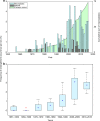The rise in ocean plastics evidenced from a 60-year time series
- PMID: 30992426
- PMCID: PMC6467903
- DOI: 10.1038/s41467-019-09506-1
The rise in ocean plastics evidenced from a 60-year time series
Abstract
Plastic production has increased exponentially since its use became widespread in the 1950s. This has led to increased concern as plastics have become prevalent in the oceanic environment, and evidence of their impacts on marine organisms and human health has been highlighted. Despite their prevalence, very few long-term (>40 years) records of the distribution and temporal trends of plastics in the world's oceans exist. Here we present a new time series, from 1957 to 2016 and covering over 6.5 million nautical miles, based on records of when plastics have become entangled on a towed marine sampler. This consistent time series provides some of the earliest records of plastic entanglement, and is the first to confirm a significant increase in open ocean plastics in recent decades.
Conflict of interest statement
The authors declare no competing interests.
Figures



References
-
- Hoornweg, D. & Bhada-Tata, P. What a waste: A Global Review of Solid Waste Management. (The World Bank, Washington, DC, 2012).
-
- Worm, B., Lotze, H. K., Jubinville, I., Wilcox, C. & Jambeck, J. Plastic as a Persistent Marine Pollutant. Annu. Rev. Environ. Resour.42, 1–26 (2017).
-
- Shomura, R. S. & Yoshida, H. O. Proceedings of the workshop on the fate and impact of marine debris. NOAA Technical Memorandum NMFS (1985).
Publication types
LinkOut - more resources
Full Text Sources

